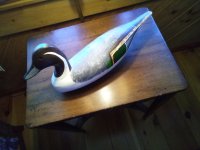somebody who makes decoys here please tell me that occasionally, you'll have one not turn out right. I hope I'm not the only one. my decoys are crude in comparison to many I see on this forum, but I hunt them anyway and they seem to work well. I enjoy this forum and learn so much from reading and seeing what others are doing.
I made a decoy this month, a wireless, canvas-covered blackduck, and when I float tested it, I found it was front-end heavy. that was a result of my choice of wood for the head, I think -- yellow pine. that was a mistake. I also used a cypress bottom board which I found to be heavier than the cedar I like to use. The cypress was considerably less expensive...again, that was a mistake, I think. Others I've made float really well and move with just the slightest breeze.
I typically use wood I have in the shop or what's easily available. but one gets what one pays for as a general rule of thumb.
Anyway, I do enjoy this forum very much and have for quite a while. I continue to look forward to the work of many others here for inspiration and ideas.
To all you craftsmen and craftswomen out there, thanks for being great.
https://www.instagram.com/p/CIJUSbunZi_/?utm_source=ig_web_copy_link


